The AMD Radeon R9 Fury Review, Feat. Sapphire & ASUS
by Ryan Smith on July 10, 2015 9:00 AM ESTCompute
Shifting gears, we have our look at compute performance. As compute performance will be more significantly impacted by the reduction in CUs than most other tests, we’re expecting the performance hit for the R9 Fury relative to the R9 Fury X to be more significant here than under our gaming tests.
Starting us off for our look at compute is LuxMark3.0, the latest version of the official benchmark of LuxRender 2.0. LuxRender’s GPU-accelerated rendering mode is an OpenCL based ray tracer that forms a part of the larger LuxRender suite. Ray tracing has become a stronghold for GPUs in recent years as ray tracing maps well to GPU pipelines, allowing artists to render scenes much more quickly than with CPUs alone.

For LuxMark with the R9 Fury X already holding the top spot, the R9 Fury cards easily take the next two spots. One interesting artifact of this is that the R9 Fury’s advantage over the GTX 980 is actually greater than the R9 Fury X’s over the GTX 980 Ti’s, both on an absolute and relative basis. This despite the fact that the R9 Fury is some 13% slower than its fully enabled sibling.
For our second set of compute benchmarks we have CompuBench 1.5, the successor to CLBenchmark. CompuBench offers a wide array of different practical compute workloads, and we’ve decided to focus on face detection, optical flow modeling, and particle simulations.
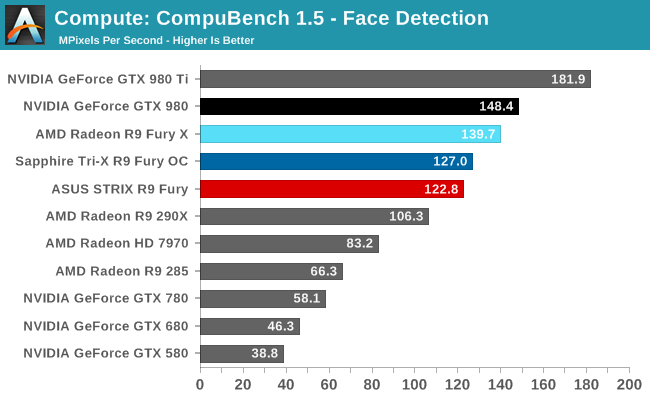
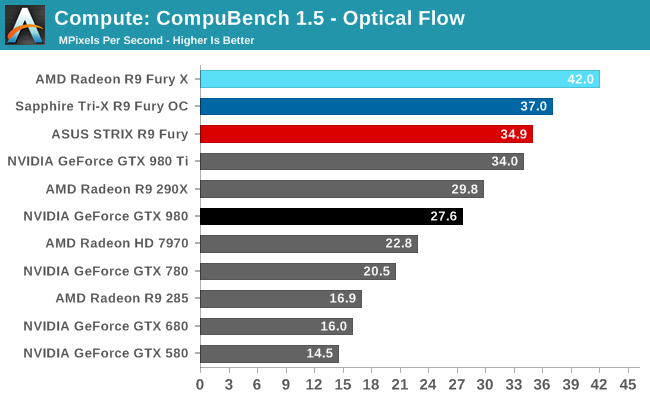

Not unlike LuxMark, tests where the R9 Fury X did well have the R9 Fury doing well too, particularly the optical flow sub-benchmark. The drop-off in that benchmark and face detection is about what we’d expect for losing 1/8th of Fiji’s CUs. On the other hand the particle simulation benchmark is hardly fazed beyond the clockspeed drop, indicating that the bottleneck lies elsewhere.
Our 3rd compute benchmark is Sony Vegas Pro 13, an OpenGL and OpenCL video editing and authoring package. Vegas can use GPUs in a few different ways, the primary uses being to accelerate the video effects and compositing process itself, and in the video encoding step. With video encoding being increasingly offloaded to dedicated DSPs these days we’re focusing on the editing and compositing process, rendering to a low CPU overhead format (XDCAM EX). This specific test comes from Sony, and measures how long it takes to render a video.
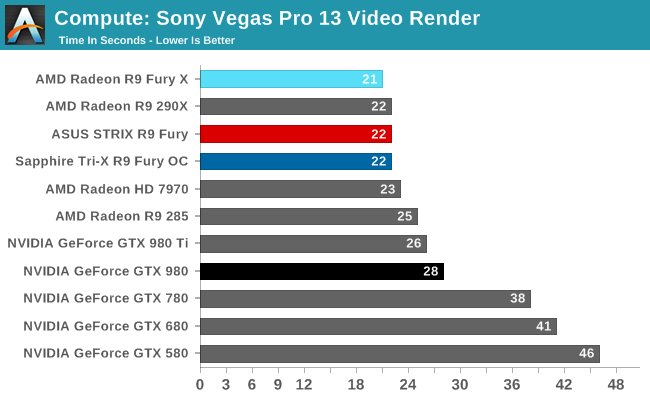
At this point Vegas is becoming increasingly CPU-bound and will be due for replacement. The R9 Fury comes in one second behind the chart-topping R9 Fury X, at 22 seconds.
Moving on, our 4th compute benchmark is FAHBench, the official Folding @ Home benchmark. Folding @ Home is the popular Stanford-backed research and distributed computing initiative that has work distributed to millions of volunteer computers over the internet, each of which is responsible for a tiny slice of a protein folding simulation. FAHBench can test both single precision and double precision floating point performance, with single precision being the most useful metric for most consumer cards due to their low double precision performance. Each precision has two modes, explicit and implicit, the difference being whether water atoms are included in the simulation, which adds quite a bit of work and overhead. This is another OpenCL test, utilizing the OpenCL path for FAHCore 17.
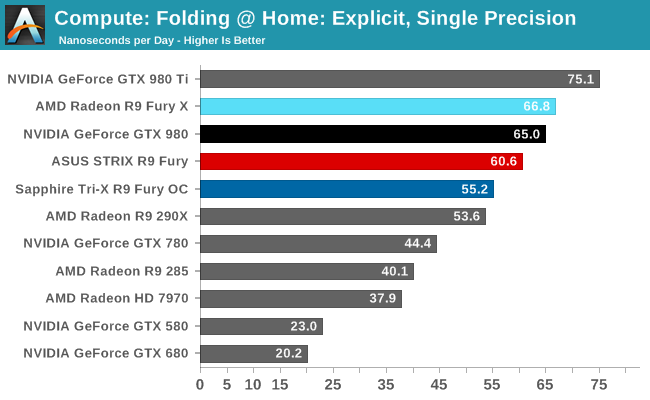
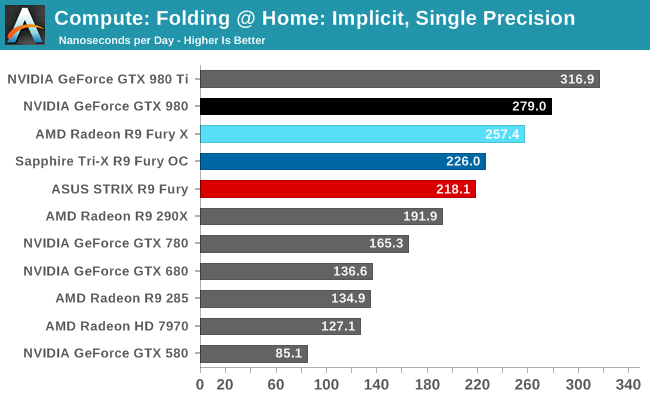

Overall while the R9 Fury doesn’t have to aim quite as high given its weaker GTX 980 competition, FAHBench still stresses the Radeon cards. Under single precision tests the GTX 980 pulls ahead, only surpassed under double precision thanks to NVIDIA’s weaker FP64 performance.
Wrapping things up, our final compute benchmark is an in-house project developed by our very own Dr. Ian Cutress. SystemCompute is our first C++ AMP benchmark, utilizing Microsoft’s simple C++ extensions to allow the easy use of GPU computing in C++ programs. SystemCompute in turn is a collection of benchmarks for several different fundamental compute algorithms, with the final score represented in points. DirectCompute is the compute backend for C++ AMP on Windows, so this forms our other DirectCompute test.
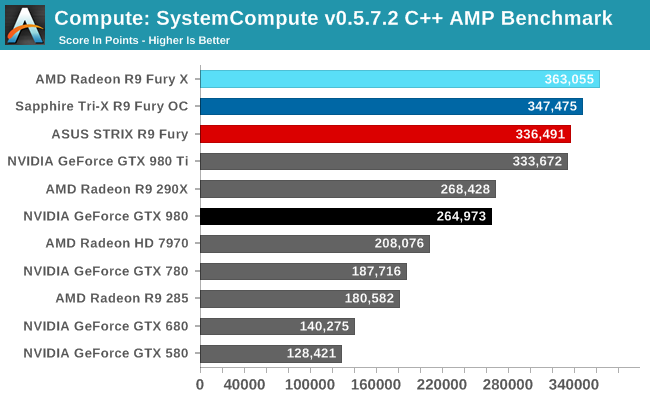
As with our other tests the R9 Fury loses some performance on our C++ AMP benchmark relative to the R9 Fury X, but only around 8%. As a result it’s competitive with the GTX 980 Ti here, blowing well past the GTX 980.










288 Comments
View All Comments
siliconwars - Saturday, July 11, 2015 - link
Any concept of performance per dollar?D. Lister - Saturday, July 11, 2015 - link
The Fury is 8% faster than a stock 980 and 10% more expensive. How does that "performance per dollar" thing work again? :pNagorak - Sunday, July 12, 2015 - link
By that token the 980 is not good performance per dollar either. It's sonething like a 390 non-x topping the charts. These high end cards are always a rip off.D. Lister - Tuesday, July 14, 2015 - link
"These high end cards are always a rip off."That, is unfortunately a fact. :(
siliconwars - Saturday, July 11, 2015 - link
The Asus Strix is 9.4% faster than the 980 with 20% worse power consumption. I wouldn't call that "nowhere near" Maxwell tbh and the Nano will be even closer if not ahead.Dazmillion - Saturday, July 11, 2015 - link
Nobody is talking about the fact that the Fury cards which AMD claims is for 4k gaming doesnt have a 4k@60Hz port!!David_K - Saturday, July 11, 2015 - link
So the displayport 1.2 connector isn't capable of sending 2160p60hz. That's new.Dazmillion - Saturday, July 11, 2015 - link
The fury cards dont come with HDMI 2.0ES_Revenge - Sunday, July 12, 2015 - link
Which is true but not the only way to get that resolution & refresh. Lack of HDMI 2.0 and full HEVC features is certainly another sore point for Fury. For the most part HDMI 2.0 affects the consumer AV/HT world though, not so much the PC world. In the PC world, gaming monitors capable of those res/refresh rates are going to have DP on them which makes HDMI 2.0 extraneous.mdriftmeyer - Sunday, July 12, 2015 - link
I'll second ES_Revenge on the DP for PC Gaming. The world of 4K Home Monitors being absent with HDMI 2.0 is something we'll live with until the next major revision.I don't even own a 4K Home Monitor. Not very popular in sales either.
Every single one of them showing up on Amazon are handicapped with that SMART TV crap.
I want a 4K Dumb Device that is the output Monitor with FreeSync and nothing else.
I'll use the AppleTV for the `smart' part.